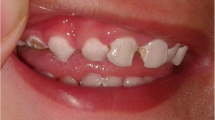Abstract
Background
Triple A syndrome (Allgrove syndrome), a rare autosomal recessive disorder, is characterized by adrenal insufficiency, achalasia cardia and alacrimia. It is caused by mutations in AAAS gene which encodes a protein called ALADIN.
Case characteristics
8-year-old boy who presented with hypoglycemic seizures, dysphagia, dry eyes and hyperpigmentation. Investigations confirmed achalasia cardia and adrenal insufficiency. Sequencing of AAAS gene revealed two novel mutations in compound heterozygous state (c.1101delG/ c.1310_1311delCT).
Outcome
Patient was managed with hydrocortisone and artificial tears.
Message
Sequencing analysis should be done to confirm the diagnosis of clinically suspected Triple A syndrome.
Similar content being viewed by others
References
Allgrove J, Clayden GS, Grant DB, Macauley JC. Familial glucocorticoid deficiency with achalasia of the cardia and deficient tear production. Lancet. 1978;1:1284–6.
Clark AJL, Weber A. Adrenocorticotropin insensitivity syndromes. Endocr Rev. 1998;19:828–43.
Tullio-Pelet A, Salomon R, Hadj-Rabia S, Mugnier C, de Laet MH, Chaouachi B, et al. Mutant WD-repeat protein in triple-A syndrome. Nat Genet. 2000;26:332–5.
Handschug K, Spering S, Yoon SJK, Hennig S, Clark AJL, Huebner A. Triple A syndrome is caused by mutations in AAAS, a new WD-repeat protein gene. Hum Mol Genet. 2001;10:283–90.
El-Rayyes K, Hegab S, Besisso MA. Syndrome of alacrima, achalasia, and neurologic anomalies without adrenocortical insufficiency. J Pediatr Ophthalmol Strabismus. 1991;28:35–7.
Prpic I, Huebner A, Persic M, Handschug K, Pavletic M. Triple A syndrome: genotype-phenotype assessment. Clin Genet. 2003;63:415–7.
Weber A, Wienker TF, Jung M, Easton D, Dean HJ, Heinrichs C, et al. Linkage of the gene for the triple A syndrome to chromosome 12q13 near the type IIkeratin gene cluster. Hum Mol Genet. 1996;5:2061–6.
The Human Gene Mutation Database. Available from: www.hgmd.cf.ac.uk/ac/gene.php?gene=AAAS. Accessed September 30, 2014.
Mukhyopadhya A, Danda S, Huebner A, Chacko A. Mutations of the AAAS gene in an Indian family with Allgrove’s syndrome. World J Gastroenterol. 2006;12:4764–6.
Cronshaw JM, Krutchinsky AN, Zhang W, Chait BT, Matunis MJ. Proteomic analysis of the mammalian nuclear pore complex. J Cell Biol. 2002;158:915–27.
Author information
Authors and Affiliations
Corresponding author
Rights and permissions
About this article
Cite this article
Sanghvi, J., Asati, A.A., Kumar, R. et al. Novel mutations in a patient with triple a syndrome. Indian Pediatr 52, 805–806 (2015). https://doi.org/10.1007/s13312-015-0722-y
Received:
Revised:
Accepted:
Published:
Issue Date:
DOI: https://doi.org/10.1007/s13312-015-0722-y




